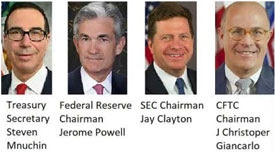Two big questions have been front and center for Fed watchers in recent months…
The first is just how high rates could go before stimulus-addicted markets would falter. The second is whether our central bankers would bow to pressure once markets faltered and politicians began calling for the Fed to resume easy money policies.
Both questions now seem to have an answer.
They began to wonder in earnest if sky-high stock market valuations could be supported in an environment where Fed officials promised to keep rates moving even higher for the foreseeable future.
The equity markets spent most of the last quarter of the year puking and retching.
The second question was answered by the change in posture of bankers at the Fed and the apparent activities of the Working Group on Financial Markets, aka the Plunge Protection team.
Central bank officials have been working to dismantle the powerful consensus they previously built around monetary policy for 2019. Up until just a few weeks ago, the prospect of ongoing bond sales and 3-4 rate hikes over the course of this year was widely considered likely.
Today, that consensus is gone.
When the selloff in the equity markets got serious, President Donald Trump and other administration officials ramped up the criticism of Fed Chair Jerome Powell and the central bank’s policy of tightening.

The Plunge Protection Team Is Active in the Markets Again
When the selloff in stocks hit its crescendo in late December, Treasury Secretary Steve Mnuchin made a high-profile call to the CEOs of the six largest banks. The next day, Christmas Eve, he held a conference call with the Plunge Protection Team. The day after Christmas, stocks enjoyed the largest single-day point rally in history!
So far this year stocks are off to the best start they have had in more than 30 years. Coincidence? We don’t think so.
These days Fed officials are telegraphing a 180-degree shift in policy. Just last week Kansas City Fed President Esther George implied that she and the other central planners will change course and stop selling from the $4.5 trillion hoard of bonds accumulated during the period of “Quantitative Easing.”
As that supply of Treasuries dries up, prices can be expected to rise and yields to fall. Stock prices rallied on the news.
The 10-year bond yield now sits at around 2.7% – down dramatically since October. The lower rates and intervention of Wall Street bankers and the Plunge Protection Team have worked wonders for the equity markets.
Investors now have to assume the Fed is “playing ball” with the President. Officials there will be working diligently to keep interest rates artificially low and weaken the dollar. This comes as little surprise to many of the critics of our monetary policy.
Our markets are hopelessly addicted to stimulus and almost no one in Washington or on Wall Street is ready to endure the withdrawal symptoms associated with going cold turkey.
The Fed will instead keep blowing bubbles, including the mother of all bubbles – U.S. debt. Investors should prepare accordingly.
Clint Siegner is a Director at Money Metals Exchange, a precious metals dealer recently named “Best in the USA” by an independent global ratings group. A graduate of Linfield College in Oregon, Siegner puts his experience in business management along with his passion for personal liberty, limited government, and honest money into the development of Money Metals’ brand and reach. This includes writing extensively on the bullion markets and their intersection with policy and world affairs.


Be the first to comment on "Fed Folds Under Pressure, Telegraphs Looser Money Ahead"